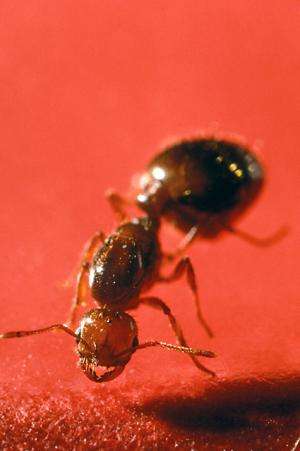Researchers study fire ant venom as natural fungicide

Red imported fire ants are named for the firelike burn of their sting. Now, the same venom that packs such a painful wallop may actually do some good for a change.
Studies by scientists at the Agricultural Research Service's Biological Control of Pests Research Unit in Stoneville, Mississippi, have shown that certain alkaloid compounds in the venom—namely, piperideines and piperidines—can hinder growth of Pythium ultimum, a top crop pathogen worldwide.
Chemical controls, delayed plantings, and crop rotation are among methods now used against P. ultimum, which causes damping-off diseases that decay the seed or seedlings of vegetable, horticultural, and cucurbit crops. Despite such measures, damping-off remains a costly problem, and new approaches are needed, notes Xixuan Jin, an ARS microbiologist. He coinvestigated the potential application of fire ant venom in the management of soilborne plant pathogens with ARS entomologist Jian Chen and Shezeng Li of the Institute of Plant Protection in Baoding, China.
Research groups have studied the insecticidal and antibiotic properties of fire ant venom since the 1950s, including against crop pests such as fruit flies and boll weevils, and bacteria such as Escherichia coli. However, the Stoneville team is the first group not only to identify piperideine alkaloids, but also to demonstrate the properties of both piperideines and piperidines against soilborne plant-pathogenic P. ultimum.
The team demonstrated this on two fronts—in petri dish experiments using P. ultimum colonies and in greenhouse trials with container-grown cucumber seedlings. In the first experiments, the team exposed the pathogen's threadlike growth form, called "mycelium," to various piperideine or piperidine concentrations and monitored the effect on the colony size of P. ultimum. The pathogen's sporangia, or spore-forming structures, were also exposed to the two alkaloids. In the greenhouse trials, the alkaloids were mixed separately in a solution and applied to cucumber seedlings as a drench treatment.
The results, reported in 2012 Pest Management Science, include significant reductions in growth and germination of P. ultimum mycelium. Both alkaloids performed equally well and retained their activity against P. ultimum for up to 12 weeks when stored at room temperature. In petri dish experiments, more than 90 percent of sporangia failed to germinate when exposed to piperideine or piperidine concentrations of 51.2 micrograms per milliliter of solution. Higher amounts (56.5 and 565.2 micrograms/milliliter) were effective in greenhouse experiments. Additionally, cucumber seedlings treated with the alkaloids grew taller than untreated seedlings.
Despite the alkaloids' promise in managing damping-off diseases caused by P. ultimum, "Further studies on disease-control mechanisms and phytotoxicity are needed," says Xixuan.
In their experiments, the researchers used sophisticated extraction techniques to obtain purified amounts of piperdeine and piperidine from the venom glands of both red and black imported fire ants. Producing commercial amounts would require considerable scale-up, even though these biting, stinging pests are a plentiful "resource," infesting over 320 million acres in the South, where they've become a dominant species as well as in other states and Puerto Rico.
One approach may arise from the work of a University of Mississippi team, which has succeeded in creating synthetic versions, or "analogs," that mimic piperideines identified by the Stoneville group. Two of seven synthesized analogs, even when used at especially low concentrations, were effective at inhibiting several cultured human fungal pathogens, raising the prospects for the analogs' use as novel antifungal agents.
"Fire Ant Venom Compounds May Be Useful as a Fungicide" was published in the August 2013 issue of Agricultural Research magazine.
More information: www.ars.usda.gov/is/AR/archive/aug13/
Journal information: Pest Management Science , Agricultural Research
Provided by Agricultural Research Service


















